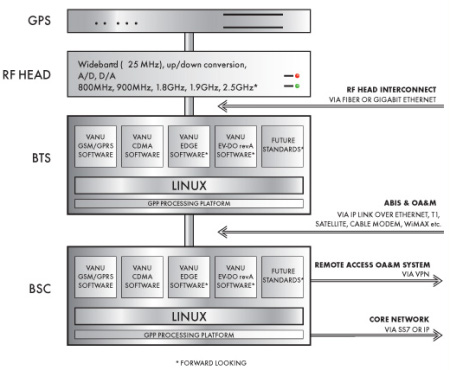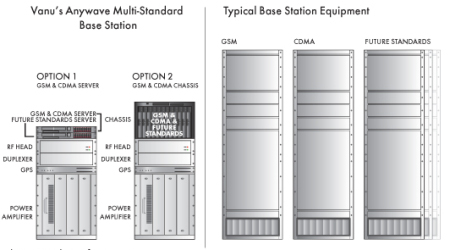Linux-based SDR targets 700MHz Femtocells
Nov 13, 2007 — by Eric Brown — from the LinuxDevices Archive — 8 viewsVanu Inc. and BitWave Semiconductor have demonstrated a Linux-based software-defined radio (SDR) for wireless Femtocell base stations. Designed to handle the 700MHz spectrum due to be auctioned in January, the SDR offers simultaneous operation of multiple standards, enabling a fast transition to multifaceted Femtocells, says Vanu.
The companies claim to have successfully demonstrated a 700MHz prototype for Femtocells — small, low-capacity cellular base-stations similar to WiFi access points. Typically connected via broadband cable or DSL connections, Femotocells are designed to extend and improve wireless coverage in homes and offices. The prototype combines the Vanu Anywave Software Radio technology, which Vanu claims to be the first FCC-certified software radio for base stations, with BitWave's Softransceiver RFIC for SDR.

Vanu Anywave Radio Access Network diagram
(Click to enlarge)
SDR can handle wireless communications tasks within software, says Vanu, offering easier reprogramming and reduced hardware expenditures in a world of quickly multiplying wireless standards. The technology caught on first with cell phones looking for an affordable path to multi-protocol support, but it's increasingly being used in cellular base stations.

Vanu Anywave server compared to proprietary base-station systems
(Click to enlarge)
Vanu and BitWave have previously collaborated on SDR solutions for 850, 1800, and 1900 MHz base stations. Because Anywave enables providers to download software upgrades to support new protocols instead of adding new hardware, and because its servers use Linux and off-the-shelf x86 hardware, Vanu says it is easier and more affordable to support multiple standards such as simultaneous GSM and CDMA service.
700MHz Gold Rush
SDR could also play a key role in the much-anticipated 700MHz spectrum that will go up for FCC auction in January. Reclaimed from TV broadcasters, the spectrum is particularly attractive to wireless providers for the Femotcell market because its low-frequency radio waves more easily penetrate walls. Vanu said that SDR could be particularly useful for the “D-Block” portion that's been designated for a nationwide emergency response network, due to the technology's ability to quickly support new public-safety standards.
According to Vanu, providers who win auction blocks should be able to reach market more quickly with an SDR solution than with proprietary hardware. Stated Vanu Bose, CEO of Vanu, “The Vanu Anywave architecture … will allow us to quickly modify the system to meet the home, enterprise and outdoor macro cellular coverage requirements of the winners of the upcoming 700MHz auction. Using the same software will allow for a seamless 700 MHz network deployment for outdoor and indoor coverage.”
Russ Cyr, Chief Marketing Officer of BitWave, stated that the combined SDR technology will enable Femtocell designers to “create a single production SKU for systems operating at different frequencies and on different standards across the globe.”
This article was originally published on LinuxDevices.com and has been donated to the open source community by QuinStreet Inc. Please visit LinuxToday.com for up-to-date news and articles about Linux and open source.